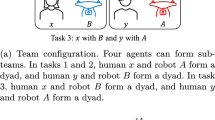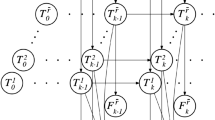Abstract
With the development of intelligent technology, autonomous agents are no longer just simple tools; they have gradually become our partners. This paper presents a trust-based human-autonomous teaming (HAT) framework to realize tactical coordination between human and autonomous agents. The proposed trust-based HAT framework consists of human and autonomous trust models, which leverage a fusion mechanism to fuse multiple performance metrics to generate trust values in real-time. To obtain adaptive trust models for a particular task, a reinforcement learning algorithm is used to learn the fusion weights of each performance metric from human and autonomous agents. The adaptive trust models enable the proposed trust-based HAT framework to coordinate actions or decisions of human and autonomous agents based on their trust values. We used a ball-collection task to demonstrate the coordination ability of the proposed framework. Our experimental results show that the proposed framework can improve work efficiency.
This work was supported in part by the Australian Research Council (ARC) under discovery grant DP210101093 and DP220100803. Research was also sponsored in part by the Australia Defence Innovation Hub under Contract No. P18-650825, US Office of Naval Research Global under Cooperative Agreement Number ONRG - NICOP - N62909- 19-1-2058, and AFOSR - DST Australian Autonomy Initiative agreement ID10134. We also thank the NSW Defence Innovation Network and NSW State Government of Australia for financial support in part of this research through grant DINPP2019 S1-03/09 and PP21-22.03.02.
Access this chapter
Tax calculation will be finalised at checkout
Purchases are for personal use only
Similar content being viewed by others
References
Baevsky, R., Bennett, B., Bungo, M., Charles, J., Goldberger, A., Nikulina, G.: Adaptive responses of the cardiovascular system to prolonged spaceflight conditions: assessment with holter monitoring. J. Cardiovasc. Diag. Proc. 14(2), 53–57 (1997)
Dimuro, G.P., et al.: The state-of-art of the generalizations of the choquet integral: from aggregation and pre-aggregation to ordered directionally monotone functions. Inf. Fusion 57, 27–43 (2020)
Hancock, P.A., Billings, D.R., Schaefer, K.E., Chen, J.Y., De Visser, E.J., Parasuraman, R.: A meta-analysis of factors affecting trust in human-robot interaction. Hum. Fact. 53(5), 517–527 (2011)
Hoeks, B., Ellenbroek, B.A.: A neural basis for a quantitative pupillary model. J. Psychophysiol. 7, 315–315 (1993)
Michel, O.: Cyberbotics ltd. webots\(^{{\rm TM}}\): professional mobile robot simulation. In. J. Adv. Rob. Syst. 1(1), 5 (2004)
Mutlu, B., Terrell, A., Huang, C.M.: Coordination mechanisms in human-robot collaboration. In: Proceedings of the Workshop on Collaborative Manipulation, 8th ACM/IEEE International Conference on Human-Robot Interaction, pp. 1–6. Citeseer (2013)
Nicora, M.L., Ambrosetti, R., Wiens, G.J., Fassi, I.: Human-robot collaboration in smart manufacturing: Robot reactive behavior intelligence. J. Manuf. Sci. Eng. 143(3) (2021)
O’Neill, T., McNeese, N., Barron, A., Schelble, B.: Human-autonomy teaming: a review and analysis of the empirical literature. Human Fact., 0018720820960865 (2020)
van Ravenswaaij-Arts, C.M., Kollee, L.A., Hopman, J.C., Stoelinga, G.B., van Geijn, H.P.: Heart rate variability. Ann. Internal Med. 118(6), 436–447 (1993)
Sadrfaridpour, B., Saeidi, H., Burke, J., Madathil, K., Wang, Y.: Modeling and control of trust in human-robot collaborative manufacturing. In: Mittu, R., Sofge, D., Wagner, A., Lawless, W.F. (eds.) Robust Intelligence and Trust in Autonomous Systems, pp. 115–141. Springer, Boston, MA (2016). https://doi.org/10.1007/978-1-4899-7668-0_7
Shahrdar, S., Park, C., Nojoumian, M.: Human trust measurement using an immersive virtual reality autonomous vehicle simulator. In: Proceedings of the 2019 AAAI/ACM Conference on AI, Ethics, and Society, pp. 515–520 (2019)
Shively, R.J., Lachter, J., Brandt, S.L., Matessa, M., Battiste, V., Johnson, W.W.: Why human-autonomy teaming? In: Baldwin, C. (ed.) AHFE 2017. AISC, vol. 586, pp. 3–11. Springer, Cham (2018). https://doi.org/10.1007/978-3-319-60642-2_1
Spencer, D.A., Wang, Y.: SLQR suboptimal human-robot collaborative guidance and navigation for autonomous underwater vehicles. In: 2015 American Control Conference (ACC), pp. 2131–2136. IEEE (2015)
Sutton, R.S., Barto, A.G.: Reinforcement Learning: An Introduction. MIT press, Cambridge (2018)
Wang, Y., Shi, Z., Wang, C., Zhang, F.: Human-robot mutual trust in (semi)autonomous underwater robots. In: Koubaa, A., Khelil, A. (eds.) Cooperative Robots and Sensor Networks 2014. SCI, vol. 554, pp. 115–137. Springer, Heidelberg (2014). https://doi.org/10.1007/978-3-642-55029-4_6
Author information
Authors and Affiliations
Corresponding author
Editor information
Editors and Affiliations
Rights and permissions
Copyright information
© 2022 The Author(s), under exclusive license to Springer Nature Switzerland AG
About this paper
Cite this paper
Ma, W., Chang, YC., Wang, YK., Lin, CT. (2022). Human-Autonomous Teaming Framework Based on Trust Modelling. In: Aziz, H., Corrêa, D., French, T. (eds) AI 2022: Advances in Artificial Intelligence. AI 2022. Lecture Notes in Computer Science(), vol 13728. Springer, Cham. https://doi.org/10.1007/978-3-031-22695-3_49
Download citation
DOI: https://doi.org/10.1007/978-3-031-22695-3_49
Published:
Publisher Name: Springer, Cham
Print ISBN: 978-3-031-22694-6
Online ISBN: 978-3-031-22695-3
eBook Packages: Computer ScienceComputer Science (R0)




